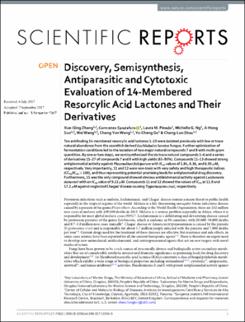Evaluation of antiparasitic, anticancer, antimicrobial and hypoglycemic properties of organic extracts from Panamanian mangrove plants

View/
Date
2018-01-02Author
Lopez, Dioxelis
Cherigo, Lilia
de Sedas, Alejandro
Spadafora, Carmenza
Martinez, Luis sergio
Metadata
Show full item recordAbstract
To investigate 33 organic extracts of mangrove plants for: antiparasitic, anticancer, and antibacterial activities, as well as their ability to inhibit the activity of the 毩-glucosidase enzyme. Methods: Leaves from all different plant mangrove species located in five mangrove zones of the Pacific coast of Panama were collected according to standard procedures. Qualitative phytochemical analysis of the organic extracts was performed by thin layer chromatography. The antiparasitic activity against Plasmodium falciparum, Trypanosoma cruzi and Leishmania donovani, toxicity against Artemia salina, anticancer activity in MCF-7 cell line, and antibacterial activity against Staphylococcus aureus, Bacillus subtilis, Escherichia coli and Pseudomonas aeruginosa of all organic extract were investigated according protocols stablished in our institution. Finally, the ability to inhibit the enzymatic activity of 毩-glucosidase was evaluated by monitoring the hydrolysis of p-nitrophenyl 毩-Dglucopyranoside. Results: Thirty-three different samples belonging to nine different species of vascular plants with seeds of true mangroves were collected. Triterpenoids, phenolics, and tannins were the main groups of compounds found in the sampled mangroves. Saponins, quinones, and coumarins were found in less than 50% of the samples. Laguncularia racemosa showed moderate activity against Plasmodium falciparum. None of the extracts presented anticancer activity. Rhizophora mangle exhibited potent activity against Staphylococcus aureus and Bacillus subtilis [(90.41±7.33)% and (96.02±6.14)% of inhibition]; Avicennia germinans and Conocarpus erectus had activity against Escherichia coli [(71.17±6.15)% and (60.60±5.13)% of inhibition, respectively]. About 60% of the mangroves showed 毩-glucosidase inhibitory activity. In particular, extracts from Laguncularia racemosa, Pelliciera rhizophorae, Conocarpus erectus, Mora oleifera, and Tabebuia palustris species showed 毩-glucosidase inhibitory potential, with IC50 values of (29.45±0.29), (20.60±0.70), (730.06±3.74), (25.59±0.37), and (853.39±5.30) µg/mL, respectively. Conclusions: Panamanian mangroves are mainly a promising potential source of hypoglycemic compounds, specifically 毩-glucosidase inhibitors. These results highlight the therapeutic virtues of extracts from American mangrove plants.
